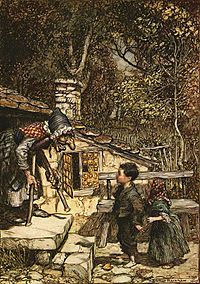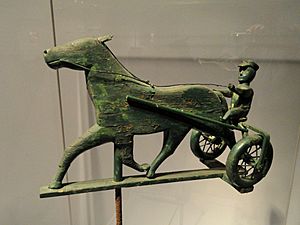Folklore facts for kids
Folklore is all about the cool traditions, stories, and customs that a group of people share. Think of it as the special way a community expresses itself! This includes things like exciting stories, fun music, lively dances, old legends, and even funny jokes. It's also about the special ways people believe and act, passed down through generations.
When people study folklore seriously, it's called folkloristics. They learn about how these traditions shape a culture.
Contents
Stories and Songs: Verbal Folklore
Verbal folklore means words that are spoken, sung, or written. These words often have patterns that repeat. It's not just any talk, but special phrases and stories that people recognize.
For example, think of the children's song Old MacDonald Had a Farm. Each time you sing it, you might name different animals or make different sounds. But the song's pattern stays the same. Songs like this help teach kids about things like farms and animals. This is how verbal folklore works!
Here are some types of verbal folklore:
- Aloha (a greeting)
- Blessings
- Bluegrass music
- Cinderella (a fairy tale)
- Conspiracy theories
- Country music
- Epic poetry (long poems about heroes)
- Fables (stories with a lesson)
- Fairy tales
- Folk music
- Folk speech (special words or phrases)
- Folktales
- Jokes
- Legends
- Myths
- Riddles
- Superstitions
Things We Make: Material Folklore
Material folklore includes all the objects you can touch, hold, or use. These are things people make by hand for a special purpose. They can be simple, like a handmade pot, or more complex.
Even things made in factories, like dreidels or Christmas decorations, can be folklore. This is because they have a long history and are used in traditional ways. Folklorists study how these items are made, how they are used, and what they mean to the people who create and use them. They also look at how these objects stay the same over time, but also change a little.
Here are some examples of material folklore:
- Embroidery (decorative sewing)
- Handicrafts (things made by hand)
- Haystacks (how hay is piled)
- Pottery (clay objects)
- Woodworking (things made from wood)
Ways We Act: Customary Folklore
Customary folklore is about the traditional ways people behave in a group. It's the "expected way of doing things." A custom can be a simple action, like a handshake. Or it can be a big event, like a child's birthday party.
A birthday party is a great example because it combines many types of folklore:
- Verbal folklore: Singing the Happy Birthday song.
- Material folklore: Giving presents and having a birthday cake.
- Customs: Playing special games like Musical chairs and making a wish before blowing out candles.
Each part of a birthday party is a piece of folklore. Together, they create the custom of celebrating a birthday.
Folklorists group customs into different types:
- Seasonal celebrations: Like Thanksgiving or New Year's.
- Life cycle celebrations: Events for an individual, like a baptism, birthday, or wedding.
- Community festivals: Big events for a whole town, like Carnival in Cologne or Mardi Gras in New Orleans.
Here are some examples of customary folklore:
- Amish traditions
- Birthday celebrations
- Christmas traditions
- Halloween
- Groundhog Day
- Mime (a type of performance)
- Symbols (like gestures)
- Thanksgiving
- Whaling customs
- Yo-yos (how they are used in games)
Kids' Traditions and Games: Childlore
Childlore is a special part of folklore. It focuses on the activities and traditions that children pass on to each other. These are things kids learn and share away from adults.
Children have their own unique culture. They teach each other games, songs, and rhymes. This "street culture" often goes unnoticed by adults. It shows that children have their own distinct ways of doing things.
Here are some examples of childlore and games:
- Dreidel games
- Eeny, meeny, miny, moe (a counting-out rhyme)
- Games
- Traditional games
- London Bridge Is Falling Down (a game and song)
- Lullabies
- Nursery rhymes
- Playground songs
- Rhymes
- Riddles
- Ring a Ring o Roses (a game and song)
- Jump-rope rhymes
- Stickball
- Street games
Images for kids
-
Netherlandish Proverbs by Pieter Bruegel the Elder, 1559
-
Indian Folk Worship at Batu Caves, Selangor Malaysia
-
Serbian Folk Group, Music and Costume. A group of performers sharing traditional Serbian folk music on the streets of Belgrade, Serbia.
-
United Arab Emirates traditional folk dance, the women flip their hair sideways in brightly coloured traditional dress.
-
Hajji Firuz is a fictional character in Iranian folklore who appears in the streets by the beginning of Nowruz, dances through the streets while singing and playing tambourine.
-
Children's Games by Pieter Bruegel the Elder, 1560; there are five boys playing a game of buck buck in the lower right-hand corner of the painting.
-
Some elements of folk culture might be in the center of local culture and an import part of self-identity. For instance folk dance is highly popular in Estonia and it has evolved into a sort of a national sport. XIX Estonian Dance Celebration in 2015 that was held together with Estonian Song Festival.
See also
 In Spanish: Folclore para niños
In Spanish: Folclore para niños



















